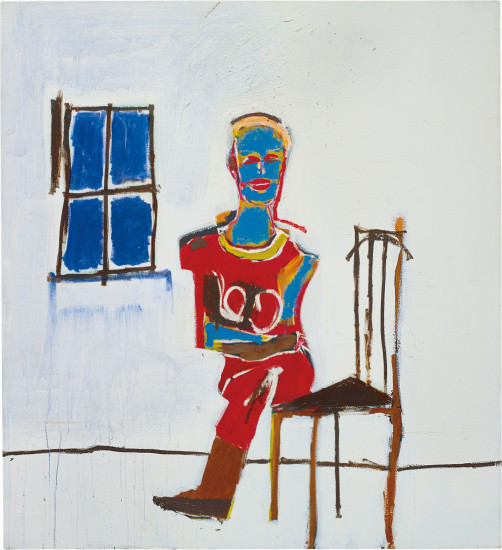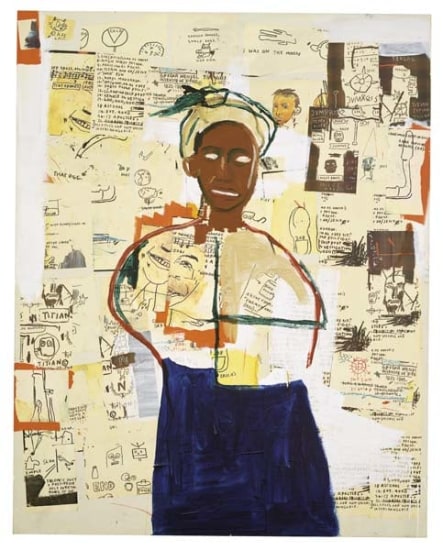12 Jean-Michel-Basquiat Irony of Negro Policeman 1981 acrylic and oilstick on wood 182.9 × 121.9 cm (72 × 48 in) Signed and dated ‘Jean Michel Basquiat 81’ on the reverse.
Provenance Collection of Dan and Jeanne Fauci Gagosian Gallery, New York Private Collection Exhibited New York, Whitney Museum of American Art, Jean-Michel-Basquiat, 21 October 1992 – 21 February 1993 Beverly Hills, CA, Gagosian Gallery, Jean-Michel-Basquiat: Paintings & Drawings, 1980–1988, 12 February – 14 March 1998 New York, Brooklyn Museum, Basquiat, 11 March – 5 June 2005, then travelled to Los Angeles, Museum of Contemporary Art (15 July – 9 October 2005), Houston, Museum of Fine Arts (18 November 2005 – 12 February 2006) Basel, Fondation Beyeler, Basquiat, 9 May – 5 September 2010, then travelled to Paris, Musée d’Art Moderne de la Ville de Paris (15 October 2010 – 30 January 2011) Literature Jean-Michel-Basquiat, exh. cat., Whitney Museum of American Art, New York, 1992 – 93, p. 84 R. D. Marshal, J. L. Prat, Jean-Michel-Basquiat, Galerie Enrico Navarra, Paris, 1996, vol. II, p. 64, No. 6 (illustrated) R. D. Marshal, J. L. Prat, Jean-Michel-Basquiat, Galerie Enrico Navarra, Paris, 2000, 3rd ed., pp. 88 – 89, No. 4 (illustrated in colour) Basquiat, exh. cat., Fondation Beyeler, Basel, 2010, p. 53 (illustrated in colour) Catalogue Essay In the majestic Irony of Negro Policeman from the pivotal year of 1981, Jean-Michel-Basquiat expounds upon the most important theme in his oeuvre, the issue which underlines his entire artistic premise: race. As an artist of mixed racial origin, the plight of black people in America fascinated Basquiat throughout his tragically short but highly prolific career. Whether in dealing with sports stars, musicians or himself, Basquiat constantly placed the black figure at the centre his artistic dialogue. His figures are heralded, commemorated and honoured as kings, heroes and martyrs valiantly battling against the odds to overcome the cynical oppression of the white man and his oppressive establishment. However, in a twist rarely seen within his oeuvre, Basquiat turns the tables to offer a sharp and biting critique on members of his own race in Irony of Negro Policeman. Against a stark white background, a black man emerges dressed in a midnight blue police uniform. His face is like a mask upon which his cap acts like a cage imprisoning his identity. This is Basquiat’s depiction of a fellow African American who has sold out to the white establishment. Basquiat’s traitor has joined an institutionalized form of whiteness, collaborating to enforce the exact laws created by whites to enslave blacks. By titling the work “IRONY OF NEGRO PLCEMN” next to the black face and also inscribing what may be read as ‘PAWN’ in the lower right corner, Basquiat is clearly suggesting that he deems it ironic that the oppressed should wear the uniform of the oppressor. Painted in the same year and executed in the same size and format, La Hara is a companion work to Irony of Negro Policeman. However, instead of depicting a slouched and dazed black officer it depicts a brutal looking skeletal of a white cop whom Basquiat has entitled ‘La Hara’, Puerto Rican pejorative slang for the police. Basquiat’s black policeman in Irony of Negro Policeman with its huge rounds eyes, gaping mouth and grid like cage around its face certainly looks more like a deer caught in headlights entrapped in an unfamiliar position, body and place than a fearsome law enforcer. Having committed the ultimate sin, the Judas-like betrayal of his race, one can sense the heavy, psychological burden weighing on Basquiat’s anonymous black policeman. However, in light of Basquiat’s infamous journey through the 1980s art world we must ask ourselves if this figure is not just an anonymous black man but rather a self-portrait. With his oeuvre as the ultimate testament, it is no secret that Basquiat’s greatest existential fight in life was his identity and his struggle for acceptance as a black man in a white art world. An examination of Basquiat’s short adult life reveals that Irony of a Negro Policeman can be read as profoundly biographical. Basquiat’s ar
12 Jean-Michel-Basquiat Irony of Negro Policeman 1981 acrylic and oilstick on wood 182.9 × 121.9 cm (72 × 48 in) Signed and dated ‘Jean Michel Basquiat 81’ on the reverse.
Provenance Collection of Dan and Jeanne Fauci Gagosian Gallery, New York Private Collection Exhibited New York, Whitney Museum of American Art, Jean-Michel-Basquiat, 21 October 1992 – 21 February 1993 Beverly Hills, CA, Gagosian Gallery, Jean-Michel-Basquiat: Paintings & Drawings, 1980–1988, 12 February – 14 March 1998 New York, Brooklyn Museum, Basquiat, 11 March – 5 June 2005, then travelled to Los Angeles, Museum of Contemporary Art (15 July – 9 October 2005), Houston, Museum of Fine Arts (18 November 2005 – 12 February 2006) Basel, Fondation Beyeler, Basquiat, 9 May – 5 September 2010, then travelled to Paris, Musée d’Art Moderne de la Ville de Paris (15 October 2010 – 30 January 2011) Literature Jean-Michel-Basquiat, exh. cat., Whitney Museum of American Art, New York, 1992 – 93, p. 84 R. D. Marshal, J. L. Prat, Jean-Michel-Basquiat, Galerie Enrico Navarra, Paris, 1996, vol. II, p. 64, No. 6 (illustrated) R. D. Marshal, J. L. Prat, Jean-Michel-Basquiat, Galerie Enrico Navarra, Paris, 2000, 3rd ed., pp. 88 – 89, No. 4 (illustrated in colour) Basquiat, exh. cat., Fondation Beyeler, Basel, 2010, p. 53 (illustrated in colour) Catalogue Essay In the majestic Irony of Negro Policeman from the pivotal year of 1981, Jean-Michel-Basquiat expounds upon the most important theme in his oeuvre, the issue which underlines his entire artistic premise: race. As an artist of mixed racial origin, the plight of black people in America fascinated Basquiat throughout his tragically short but highly prolific career. Whether in dealing with sports stars, musicians or himself, Basquiat constantly placed the black figure at the centre his artistic dialogue. His figures are heralded, commemorated and honoured as kings, heroes and martyrs valiantly battling against the odds to overcome the cynical oppression of the white man and his oppressive establishment. However, in a twist rarely seen within his oeuvre, Basquiat turns the tables to offer a sharp and biting critique on members of his own race in Irony of Negro Policeman. Against a stark white background, a black man emerges dressed in a midnight blue police uniform. His face is like a mask upon which his cap acts like a cage imprisoning his identity. This is Basquiat’s depiction of a fellow African American who has sold out to the white establishment. Basquiat’s traitor has joined an institutionalized form of whiteness, collaborating to enforce the exact laws created by whites to enslave blacks. By titling the work “IRONY OF NEGRO PLCEMN” next to the black face and also inscribing what may be read as ‘PAWN’ in the lower right corner, Basquiat is clearly suggesting that he deems it ironic that the oppressed should wear the uniform of the oppressor. Painted in the same year and executed in the same size and format, La Hara is a companion work to Irony of Negro Policeman. However, instead of depicting a slouched and dazed black officer it depicts a brutal looking skeletal of a white cop whom Basquiat has entitled ‘La Hara’, Puerto Rican pejorative slang for the police. Basquiat’s black policeman in Irony of Negro Policeman with its huge rounds eyes, gaping mouth and grid like cage around its face certainly looks more like a deer caught in headlights entrapped in an unfamiliar position, body and place than a fearsome law enforcer. Having committed the ultimate sin, the Judas-like betrayal of his race, one can sense the heavy, psychological burden weighing on Basquiat’s anonymous black policeman. However, in light of Basquiat’s infamous journey through the 1980s art world we must ask ourselves if this figure is not just an anonymous black man but rather a self-portrait. With his oeuvre as the ultimate testament, it is no secret that Basquiat’s greatest existential fight in life was his identity and his struggle for acceptance as a black man in a white art world. An examination of Basquiat’s short adult life reveals that Irony of a Negro Policeman can be read as profoundly biographical. Basquiat’s ar

.jpg)









Try LotSearch and its premium features for 7 days - without any costs!
Be notified automatically about new items in upcoming auctions.
Create an alert